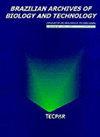Chemical Profile of Essential Oil, Extracts and Fractions of Eugenia pyriformis Cambess. and its Antioxidant, Cytotoxic and Allelopathic Activities
IF 1.1
4区 生物学
Q3 BIOLOGY
引用次数: 0
Abstract
: The chemical investigation of Eugenia pyriformis , popularly known as uvaia, led to the isolation of three compounds, the triterpene β -amiryn ( 1 ) and the porphyrin derivatives pheophytin a ( 2 ) and b ( 3 ). Their structures were assigned based on spectroscopic NMR analysis, as well as by comparison with literature data. Most of the compounds found in the essential oil from leaves are terpenes derivatives, such as ο - cymene; 1,8-cineol; linalol, terpinen-4-ol; 2-carene. Flavonoids, steroids and/or terpenoids, lactones, saponins, tannins and fixed acids were detected in both the leaf and stem crude extracts and fractions generated from the Brazilian E. pyriformis plant. According to the results of the DPPH assay, the ethyl acetate fraction of the leaf extract showed higher antioxidant activity than the other samples tested. In the phosphomolybdenum complex assay, the crude ethanol extract of the leaf and stem, and the ethyl acetate fraction of the leaf, showed a higher antioxidant capacity than rutin. It was observed that the chloroform and ethyl acetate fractions of the leaf, and the hexane, ethyl acetate and hydroalcoholic fractions of the stem were toxic to Artemia salina brine shrimp with LD 50 < 1.0 µg/mL. The hexane fraction of the stem was also allelopathic in inhibiting the radicle growth of Lactuca sativa seeds. These results adding contributions to chemical and biological studies of this medicinal species梨形栀子精油、提取物及组分的化学性质研究。及其抗氧化、细胞毒和化感作用
本文章由计算机程序翻译,如有差异,请以英文原文为准。
求助全文
约1分钟内获得全文
求助全文
来源期刊
CiteScore
1.80
自引率
0.00%
发文量
116
审稿时长
3 months
期刊介绍:
Information not localized

 求助内容:
求助内容: 应助结果提醒方式:
应助结果提醒方式:


